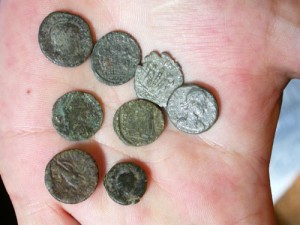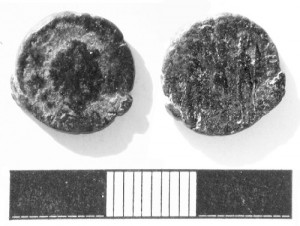
Metal detectorist Barry Seger of the Tyneside Detecting Association was searching a field in the Great Whittington area of Northumberland in May 2007. During the course of his examination of the field, he recovered 8 late Roman copper-alloy nummi all in a relatively straight line. He reported his finds to the local Finds Liaison Officer for the Portable Antiquities Scheme.
Barry explained to his FLO, Rob Collins, how he found the coins, in a zig-zag line. When they looked at a map of the field where Barry found the coins, there was an agricultural drain marked in the area where the coins were found. It became clear to Rob that the insertion of the drain probably disturbed the coins, which would have originally been in a small group very close to each other. As such, the coins could be considered a hoard, but in this case the hoard could not be declared Treasure, as there were only 8 base-metal coins rather than the required 10. Concerned that there may be more coins disturbed by the drain, Rob recommended that Barry search the area again, but no more coins were forthcoming.
The small number of coins, combination of mints, and broad range of dates suggests that the coins were the contents of a purse that was lost. A thorough study of the coins has also revealed that Barry’s hoard is exceptionally important, as it has provided the latest dated nummus to have been found in the Hadrian’s Wall corridor.
The Coins

All eight coins that Barry found were relatively small and somewhat worn copper-alloy nummi typical of the 4th century. Such coin finds are fairly common for detectorists, particularly those of Constantine the Great and his sons, and because of this frequency, many finders do not get particularly excited when they encounter a nummus. However, these coins contain a lot of information, and someone trained in the identification of Roman coinage can provide a wealth of information. Barry’s coins are listed in detail, with the primary elements separated for ease of identification and comparison.
-
Victoriae Laetae Princ Perp type, dating AD 318
Emperor: Constantine I RIC: VII p. 431, nos. 47-48
Obverse: Laureate helmeted, cuirassed bust right
Obverse Inscription: …NVS…A…
Reverse: Victories facing each other holding shield with VOT PR over central altar
Reverse Inscription: …TAE…INC PE…
Mint: ASIS*, 1st officina of Siscia (modern Croatia)
Diameter: 18.33mm Thickness: 2.03mm Weight: 2.8g
Note: There is evidence for silver washing of this coin. -
Gloria Exercitus type, dating AD 330-335
Emperor: Constantius II RIC: VII p. 581, no. 75
Obverse: Cuirassed, laureate bust right
Obverse Inscription: [F]L IVL CONSTANTIVS NOB…
Reverse: Two soldiers holding spears to the outside with one standard between them
Reverse Inscription: GLOR/IA EXER…TVS
Mint: (CO)?…, probably Constantinople
Diameter: 17.65mm Thickness: 1.43mm Weight: 1.7g -
Gloria Exercitus type, dating AD 337-341
Emperor: Constans RIC: type as VIII p. 490, no. 18
Obverse: Luareate diademed, draped and cuirassed bust right
Obverse Inscription: D[N] CONSTA/NS P F AVG
Reverse: Two soldiers holding spears to the outside with one standard between them
Reverse Inscription: …XER…
Mint: SM… (Eastern mint)
Diameter: 17.92mm Thickness: 0.92mm Weight: 1.2g
Notes: SM (Sacra Moneta) is a prefix used at mints from Heraklea eastwards in this period. -
Fel Temp Reparatio type, contemporary copy, dating c. AD 355-361
Emperor: Constans or Constantius II
RIC: type as VIII, p. 191, no. 189
Obverse: Pearl-diademed, [draped?] and cuirassed bust right
Obverse Inscription: DN CONS…
Reverse: Soldier spearing a fallen horseman
Reverse Inscription: …PAR…
Mint: worn away, probably Balkan or Eastern mint
Diameter: 16.85mm Thickness: 2.46mm Weight: 3.7g -
Fel Temp Reparatio type, a contemporary copy, dating c. AD 355-361
Emperor: Constans RIC: type as VIII, p. 191, no. 189
Obverse: Pearl-diademed, draped and cuirassed bust right
Obverse Inscription: …NS PF AVG
Reverse: Soldier spearing a fallen horseman
Reverse Inscription: FEL TEMP…
Mint: worn away, probably Balkan or Eastern mint
Diameter: 16.16mm Thickness: 1.69mm Weight: 2.2g Notes: Constans died in AD 350 when the Falling Horseman types were still being struck on a larger module. This copy was probably struck at least five years later. -
Securitas Republicae type, dating AD 364-367
Emperor: Valentinian I LRBC: II, p. 56, nos. 481-483
Obverse: Robed, diademed bust right
Obverse Inscription: …NVS PF AVG
Reverse: Security facing left with wreath and palm.
Reverse Inscription: SECVRITA…
Mint: OF/II//CONS[T], 2nd officina of Arles (France)
Diameter: 16.38mm Thickness: 1.65mm Weight: 2.0g -
Securitas Rei Publicae type, dating AD 364-378
Emperor: House of Valentinian, probably Valentinian I
RIC: IX type as p. 64, no. 9; LRBC p. 56, 501
Obverse: Pearl-diademed, draped and cuirassed bust right
Obverse Inscription: illegible
Reverse: Victory advancing left with wreath and palm
Reverse Inscription: illegible [SECVRITAS REI PVBLICAE]
Mint: •/-//[ ]CON, almost certainly Arles (as opposed to Constantinople)
Diameter: 17.01mm Thickness: 1.86mm Weight: 2.4g -
Gloria Romanorum type, dating AD 406-408
Emperor: Arcadius, Honorius or Theodosius II RIC: type as RIC X 142 ff
Obverse: Pearl-diademed, draped and cuirassed bust right; behind bust, star
Obverse Inscription: illegible
Reverse: Three emperors standing, holding spears and shields; innermost figure smaller.
Reverse Inscription: …OR…
Mint: Eastern mint
Diameter: 13.58mm Thickness: 2.14mm Weight: 2.0g Notes: This issue was struck in eastern mints of the Roman Empire - Constantinople, Nicomedia, Cyzicus, Antioch and Alexandria. These coins are very common as site-finds in the central and eastern Mediterranean, but only one has been previously recorded from Britain as a site-find or in a hoard, from Didcot in Oxfordshire (R. Abdy and G. Williams, ‘A catalogue of hoards and single finds from the British Isles, c. AD410-675, p. 30, no. 51, in B. Cooke and G. Williams (eds.), Coinage and History in the North Sea World, c. 500-1250 (Brill, 2006), pp. 11-73.
Significance of the Hoard
There are a number of important attributes to this hoard that should be pointed out. First, 5 coins are of the House of Constantine (meaning they were issued by Constantine or his sons or relatives) that date to the years AD 318-361. Two of these are the so-called ‘barbarous copies’, or provincial, cruder copies of official coins made at roughly the same date as the originals because there were not enough official coins in circulation. Two coins are of the House of Valentinian dating to AD 364-378. The latest and most exceptional coin is from the House of Theodosius, a Gloria Romanorum issue dating to AD 406-408. Without this final coin, this group would be a quite normal selection of 4th century coins. However, the Theodosian coin is only the second of its type to be recorded in Britain (Abdy and Williams 2006:30, no. 51) despite the fact that this is a common issue in the Mediterranean, being found on sites from Butrint in Albania to Beirut in Lebanon. It is even found in significant numbers in southern India and Sri Lanka.
The accepted view of late Roman bronze coinage is that no coins were shipped in bulk to Britain after AD 402. A small handful of bronze coins that post-date AD 402 have been found in Britain and this number has increased over the past 10 years through the establishment of the Portable Antiquities Scheme, but such coins are still very rare finds. Those Roman coins post-dating AD 402 that have been reported are generally found in southern England and the Midlands, and this indicates that there was coin exchange with people from the Continent in the southern half of England. This pattern is further reinforced by a distribution of the few coins we have of the British usurper Constantine III in AD 407-409. The implication of this is that northern Britain had little exchange with coin-using people from the Continent, even during the last years of Roman Britain.
Many people believe that with the end of the Roman period in Britain, typically dated to AD 409 or 410, all the soldiers were withdrawn from the island. In fact we have no concrete proof of this, but the lack of coins post-dating AD 402 has reinforced this notion. Another line of reasoning is that even if the Roman soldiers were not withdrawn by the usurper Constantine III or a legitimate Roman emperor, they would have disappeared or stopped acting as soldiers because they were no longer getting paid. Again, we have no evidence for this, and it was also quite common that some frontier soldiers would not get paid for many months or even years at a time. In such cases, they generally kept to soldiering and received their pay in due course.

The Gloria Romanorum coin is thus very important, as it can contribute to our understanding of the end of the Roman frontier and the Roman period in Britain. It also needs to be stressed that this importance has little to do with its value as a coin or as a collector piece in fact, these coins are common. The coin is significant because of its findspot, in proximity to a Roman road running northeast from the fort of Halton Chesters on Hadrian’s Wall.
At the very least, this coin demonstrates a link with people on the Continent in AD 406, and probably even later. Furthermore, the coin is from an Eastern Mediterranean mint, along with three other coins. Only the two Valentinianic coins are certainly from Western mints. This mix of mints is very important for interpretation, as most coin hoards from late Roman Britain tend to have the majority of coins from Western mints. The predominance of Eastern Mediterranean mints suggests that the coins or purse belonged to an individual that spent time in the Mediterranean, where such coins would have been circulated in greater frequency. Therefore, we can say that the coins represent a person that was well travelled, probably coming from southern France at the closest if not even further away.
Date of the Hoard
Archaeologists date hoards on the principle of a terminus post quem (TPQ), which is Latin for ‘date after which’. The principle is very simple. A hoard cannot be earlier in date than the date of the latest coin found in the hoard. Thus, the earliest possible date for the loss of the purse is AD 406, the first year in which the coin was minted. So we know for certain that the hoard is no earlier than AD 406 in date, and probably later.
The distance the coin had the travel and the degree of wear on the coin suggests it was in circulation for some time after it was initially minted. It should also be noted that bronze coins from the late 4th and early 5th centuries were often struck from worn dies which means the coins appear more ‘worn’ than they are in fact. Unfortunately, there is no further information by which to provide a precise date, which means the coin may have been in circulation for 1 or 2 years before it was deposited in Northumberland, or 10-20 years. In either case, by dating the hoard to the early 5th century, we allow for the TPQ and an unspecified amount of time by which the coin was in circulation.
It should also be pointed out that this reasoning applies only to the latest coin. That means that the oldest coin, an issue of Constantine minted in AD 318 was in circulation for at least 80 years, and it was in better condition than the latest coin. This is important, because it illustrates that coins can have a long ‘use-life’ and that the quality of production of coins can vary considerably.
Further Considerations
There are a number of other aspects that Barry’s Gloria Romanorum coin have raised. Primarily, this is one of recognition. Most Roman coins books pertaining to Britain do not depict many (if any) 5th century coin issues. So it is necessary that the identifier have experience or knowledge of late Roman coins from the Continent - in this case the Portable Antiquities Scheme’s Find Adviser for Iron Age and Roman coins, Sam Moorhead, was able to identify the coin because he has published many coins from excavations in the Mediterranean. Also, to an untrained or unfamiliar eye, Barry’s coin appears similar to a Gloria Exercitus type issued by the House of Constantine, which is a very common find. This makes me wonder if there are more of these coins out there, either found by detectorists or archaeologists that have been misidentified. Not only is this possible, but it is even likely, as if this coin has made it to northern England, there must be more throughout the rest of the country, particularly in the South.
So, I encourage you to re-examine your collections casting your eye towards late Roman coins. Are you certain which emperor issued the coin? If you have any doubts, it is best to show the coin to your local Finds Liaison Officer.